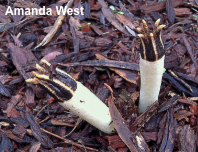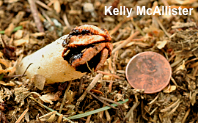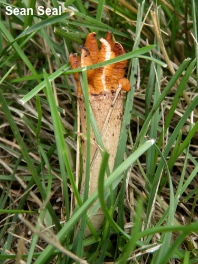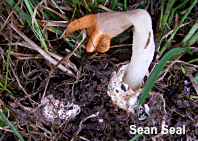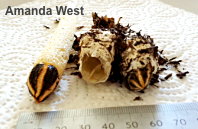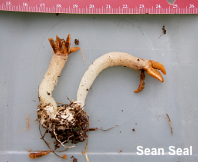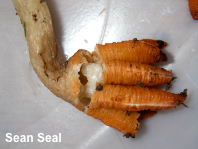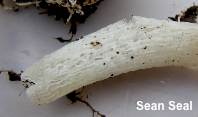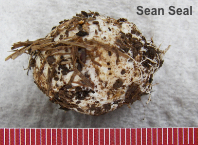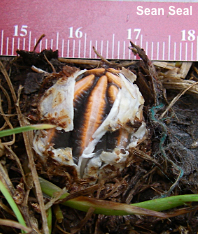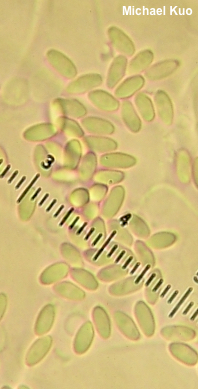| Major Groups > Stinkhorns > Lysurus cruciatus |

|
Lysurus cruciatus [ Basidiomycota > Phallales > Lysuraceae > Lysurus . . . ] by Michael Kuo This funky stinkhorn has a well-developed, round-in-cross-section stem, and a head structure that consists of several short, pointed arms that look like claws. The arms are covered with stinky, spore-filled, dark brown goo that attracts the flies and other insects that have been unwittingly duped by the mushroom into spreading its babies wherever they go next . . . and they have gone all over the place, apparently, because Lysurus cruciatus has global distribution—especially in the Southern Hemisphere, but also sometimes north of the Equator. Lysurus gardneri is a different species, although that name is often erroneously used in North American field guides to represent Lysurus cruciatus. However, Lysurus gardneri has claws that remain united at their tips, and which are only covered with spore slime from about the midpoint upwards; it is known from Asia and Africa. Lysurus mokusin is somewhat similar, but has a four- to six-sided stem that is not round in cross-section, as well as fused arms that remain joined at their tips. Lysurus borealis and Anthurus borealis are synonyms. Thanks to Kelly McAllister, Sean Seal, and Amanda West for collecting, documenting, and preserving Lysurus cruciatus for study; their collections are deposited in The Herbarium of Michael Kuo. Description: Ecology: Saprobic; growing alone or gregariously, usually in urban habitats (lawns, landscaping, gardens, and so on); widely distributed in North America; also known from South America, Africa, Asia, and Australia; summer, or, in warm climates, year round. The illustrated and described collections are from Colorado, Washington, and New South Wales, Australia. Fruiting Body: Initially a whitish "egg" up to 2 cm wide and 3 cm high; emerging to form a mushroom with a stem and a head. Stem 3–6 cm long; 0.5–1 cm thick; whitish to pale orange; round in cross-section; more or less equal; pocketed; spongy and soft; hollow; base encased in a white volva that is attached to white rhizoids. Head consisting of 4–7 short arms 1–2 cm long, initially folded inward with tips touching, but with age separating and standing individually; arms tightly wrinkled in concentric accordion-like folds; narrowed to a point at their tips; hollow; dark to pale orange; at first with a longitudinal "seam" on the outer edge—but with development the seam opens up to form a flat, sterile surface; elsewhere the young, fresh arms are coated with malodorous, dark brown spore slime. Microscopic Features: Spores 2.5–4 x 1.5–2 µm; elongated-ellipsoid to subcylindric; smooth; hyaline to yellowish in KOH; inamyloid; not cyanophilic. Context sphaerocysts 10–60 µm; subglobose to irregular; walls 1 µm thick; hyaline in KOH. Volval tissue composed of parallel hyphae 2–6 µm wide, frequently septate, clamped at septa, smooth, thin-walled, hyaline in KOH. REFERENCES: (Leprieur & Montagne, 1845) Hennings, 1902. (Saccardo, 1888; Lloyd, 1909; Dring, 1980; Smith, Smith & Weber, 1981; Arora, 1986; Pegler et al., 1995; Barron, 1999; Miller & Miller, 2006; Abrar et al., 2012; Buczacki et al., 2012; Sandoval-Leiva et al., 2014; Trierveiler-Pereira et al., 2014; Gogoi & Parkash, 2015; Baroni, 2017.) Herb. Kuo 08031301, 05061401, 06101901. This site contains no information about the edibility or toxicity of mushrooms. |
© MushroomExpert.Com |
|
Cite this page as: Kuo, M. (2019, September). Lysurus cruciatus. Retrieved from the MushroomExpert.Com Web site: http://www.mushroomexpert.com/lysurus_cruciatus.html |
